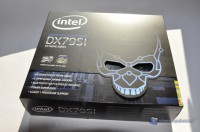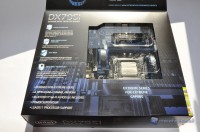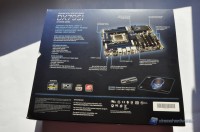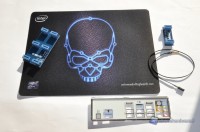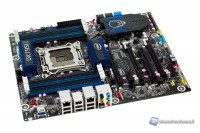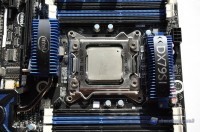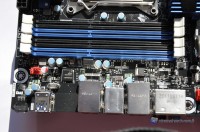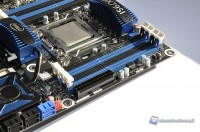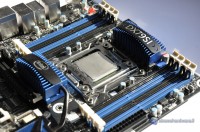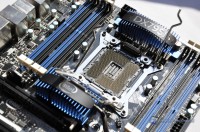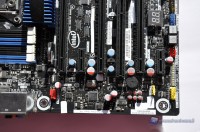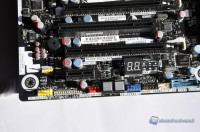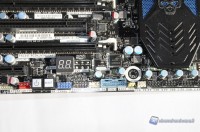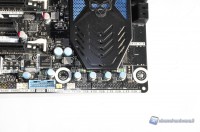DX79SI Siler, the Intel proposal for LGA 2011 motherboards
In the press kit arrived to us the motherboard is "Siler" DX79SI, the Intel proposal for LGA 2011. Despite the wide range of x79 motherboards made today by Intel partners, the Santa Clara company has not declined to propose his own model, dedicated both to the enthusiast market and both professionals.
The packaging is attractive and presents a window that appears, opening the box like a book. The bundle is not complete, at our office has arrived only the mask for the rear I/O panel, some SLI bridges, a temperature probe and an Intel mousepad.
The layout is characterized by the typical black and blue colors and a skull accompanying the very top of the range motherboards since the release of Intel Skulltrail platform.
We begin the analysis of the card from the top, where the 8 DDR3 slots stand, arranged on both sides of the socket and capable of supporting up to 64GB of memory. The proximity of the slots to the socket, requires the use of modules with low-profile heat sink, or special heat sinks, and so with liquid, tower like but narrow or with horizontal orientation. The LGA 2011 socket is always of Land Grid Array type, then with 2011 pins which sprout from the socket. The so high number of pins is due to the quad channel memory controller and the high number of PCI Express lanes. The LGA 2011 has a new docking system, equipped with a thread through the socket's holes, allowing a more practical and reliable attaching system than the old push-pin.
Above the socket is the powering system, covered by a heat sink with written DX79SI. LGA 2011 CPUs require a very efficient power supply system, because of the power required in oveclock and reduced space available, occupied on two sides by the memory modules. Therefore we almost always find "Driver" phases type MOSFET (DrMOS) accompanied by Hi-C cap type capacitors.
As expansion slots there are 3 PCI Express 3.0 x16, including two x16 electrical and one x8. There is also a PCI slot and two PCI Express 2.0 x1.
For the storage connectivity side there are two 6Gb/s SATA ports (blue) and 4 3Gb/s SATA (black), managed by the x79 chipset that is cooled by an aluminum body, printed with a skull symbol of the Extreme Desktop Board, and by a heat pipe connected to another passive dissipating body.
As for internal headers we have 4 pairs of USB 2.0, a pair of USB 3.0 supported from NEC D720200AFI controller, 1394 port and audio connectors. In this area we also note two onboard power and reset buttons and a display for debugging.
Going back to the rear connections we see from the left, the Back to BIOS button, 2 USB 3.0, 6 USB 2.0, 2 Gigabit LAN, Firewire 1394a, and finally the usual audio connections.
Interestingly, all 4 fan connectors on the motherboard are PWM.
The BIOS interface is classic. The options and overclocking modes are similar to those of Sandy Bridge, but more about that will be detailed in the following pages. For now we merely point out a feature of this motherboard called Fast Boot able to speed up boot time by skipping the POST, if the system has no changes since the last working version.

